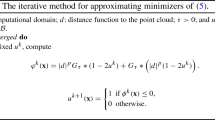Abstract
Multi-view reconstruction has been an active research topic in the computer vision community for decades. However, state of the art 3D reconstruction systems have lacked the speed, accuracy, and ease to use properties required by the industry. The work described in this paper is part of the effort to produce a multi-view reconstruction system for a UK company. A novel variational level set method is developed for reconstructing an accurate implicit surface for a set of unorganised points (point cloud). The variational model consists of three energy terms to ensure accurate and smooth surface reconstruction whilst preserving the fine details of the point cloud and increasing speed. The model also completely eliminated the need for reinitialisation associated with the level set method. Implementation details of the variational model using gradient descent optimisation are given, and the roles of its three energy terms are illustrated through numerical experiments. Experiments show that the proposed method outperformed the state of the art surface reconstruction approaches.
Access this chapter
Tax calculation will be finalised at checkout
Purchases are for personal use only
Similar content being viewed by others
References
Edelsbrunner, H., Mücke, E.P.: Three-dimensional alpha shapes. ACM Trans. Gr. 13(1), 43–72 (1994)
Amenta, N., Bern, M., Kamvysselis, M.: A new Voronoi-based surface reconstruction algorithm. In: Proceedings of the 25th Annual Conference on Computer Graphics and Interactive Techniques, pp. 415–421 (1998)
Boissonnat, J.D.: Geometric structures for three-dimensional shape representation. ACM Trans. Gr. 3(4), 266–286 (1984)
Zhao, H.K., Osher, S., Merriman, B., Kan, M.: Implicit and nonparametric shape reconstruction from unorganized data using a variational level set method. Comput. Vis. Image Underst. 80(3), 295–314 (2000). Elsevier
Zhao, H.K., Osher, S., Fedkiw, R.: Fast surface reconstruction using the level set method. In: Proceedings IEEE Workshop on Variational and Level Set Methods in Computer Vision, 2001, pp. 194–201. IEEE (2001)
Ye, J., Bresson, X., Goldtein, T., Osher, S.: A fast variational method for surface reconstruction from sets of scattered points. CAM Report, 10(01) (2010)
Liang, J., Park, F., Zhao, H.K.: Robust and efficient implicit surface reconstruction for point clouds based on convexified image segmentation. J. Sci. Comput. 54(2–3), 577–602 (2013). Springer
Osher, S., Sethian, J.A.: Fronts propagating with curvature-dependent speed: algorithms based on Hamilton-Jacobi formulations. J. Comput. Phys. 79(1), 12–49 (1988). Elsevier
Li, C.M., Xu, C.Y., Gui, C.F., Fox, M.D.: Level set evolution without re-initialization: a new variational formulation. In: IEEE Computer Society Conference on Computer Vision and Pattern Recognition, 2005. CVPR 2005, 1, pp. 430–436. IEEE (2005)
Zhao, H.K.: A fast sweeping method for eikonal equations. Math. Comput. 74(250), 603–627 (2005)
Kazhdan, M., Bolitho, M., Hoppe, H.: Poisson surface reconstruction. In: Proceedings of the fourth Eurographics symposium on Geometry processing (2006)
Caselles, V., Kimmel, R., Sapiro, G.: Geodesic active contours. Int. J. Comput. Vis. 22(1), 61–79 (1997). Springer
Rudin, L.I., Osher, S., Fatemi, E.: Nonlinear total variation based noise removal algorithms. Physica D: Nonlinear Phenom. 60(1), 259–268 (1992). Elsevier
Chan, T.F., Vese, L.A.: Active contours without edges. IEEE Trans. Image Process. 10(2), 266–277 (2001). IEEE
Author information
Authors and Affiliations
Corresponding author
Editor information
Editors and Affiliations
Rights and permissions
Copyright information
© 2015 Springer International Publishing Switzerland
About this paper
Cite this paper
Duan, J., Haines, B., Ward, W.O.C., Bai, L. (2015). Surface Reconstruction from Point Clouds Using a Novel Variational Model. In: Bramer, M., Petridis, M. (eds) Research and Development in Intelligent Systems XXXII. SGAI 2015. Springer, Cham. https://doi.org/10.1007/978-3-319-25032-8_9
Download citation
DOI: https://doi.org/10.1007/978-3-319-25032-8_9
Published:
Publisher Name: Springer, Cham
Print ISBN: 978-3-319-25030-4
Online ISBN: 978-3-319-25032-8
eBook Packages: Computer ScienceComputer Science (R0)




